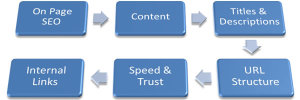
User Experience for Website (UX) in web site design is an essential element that could make or destroy the fulfillment of a website. It contains an extensive variety of factors that make a contribution to the general delight and usefulness of an internet site for its visitors. In this article, we will delve into what User Experience for a Website (UX) includes, its significance in website design, key principles, and how to put in force and powerful UX Design for a Website.
Table of Contents
What Is User Experience For Website (UX) In Website Design?
User Experience for Website (UX), frequently abbreviated as UX, is the holistic notion a person has while interacting with a website or another product. It includes the consumer’s feelings, attitudes, behaviors, and perceptions throughout and after the use of the internet site. UX Design for Website specializes in developing a continuing and enjoyable enjoyment for customers, improving satisfaction, and making sure the user’s wishes and goals are met efficiently.
User Experience for Website (UX) layout within the context of website design involves know-how of the target market, their preferences, desires, and pain factors. It’s about designing a website that is intuitive, easy to navigate, visually attractive, and meets the users’ targets seamlessly.
Importance Of User Experience For Website (UX) In Website Design
1. Enhances User Satisfaction:
A nicely-crafted UX Design for a Website ensures that users find what they may be looking for speedy and effortlessly. It removes frustrations and enhances pleasure, encouraging customers to return to the internet site.
2. Boosts Engagement And Retention:
An intuitive and tasty UX Design for a Website maintains customers on the internet site longer, increasing the probability of conversions, whether it’s creating a purchase, signing up for a newsletter, or every other preferred action.
3. Reduces Bounce Rates:
A top UX Design for a Website can notably lessen jump quotes by means of shooting visitors’ attention and motivating them to explore the website in addition, as opposed to leaving straight away.
4. Builds Trust And Credibility:
A visually appealing and easy-to-use website instills trust and credibility in the customers. They are much more likely to trust the content material, products, or services presented.
5. Optimizes Conversion Rates:
An internet site with a well-optimized UX Design for the Website courses customers easily through the conversion funnel, increasing the likelihood of accomplishing desired movements, which include creating a purchase or filling out a shape.
6. Cost-Effectiveness:
Investing in UX Design for Websites in advance can save charges in the long run by lowering the want for enormous redesigns or fixes because of terrible personal engagement or dissatisfaction.

Key Principles Of UX Design For Website
Creating a successful User Experience for a Website (UX) involves adhering to key ideas that are manual in the layout process. Here are some essential standards to take into account when designing the UX Design for Website:
1. User-Centric Design:
Understanding the target audience and designing with their needs, choices, and behaviors in mind is essential. Conduct user studies to accumulate insights and create personas to manually the design technique.
2. Usability:
The website ought to be clean to apply and navigate. Intuitive layouts, clear navigation, and a logical float of facts contribute to better usability.
3. Visual Design:
Visual factors, together with coloration schemes, typography, pix, and icons, should be chosen carefully to create a visually appealing and cohesive layout that aligns with the brand and resonates with the audience.
4. Consistency:
Maintaining consistency in layout factors, such as color, fonts, and layout, across the website guarantees a cohesive and predictable User Experience for the Website (UX).
5. Accessibility:
Designing with accessibility in mind ensures that the website is usable by humans of all competencies and disabilities. This includes concerns for customers with visual, auditory, motor, and cognitive impairments.
6. Feedback And Iteration:
Collecting feedback from users and analyzing their behavior using gear like heatmaps and user testing allows for non-stop improvement and refinement of the UX Design for the Website.
7. Performance:
Ensuring that the internet site loads quickly and operates easily across diverse devices and structures is essential for a high-quality User Experience for a Website (UX).
Implementing Effective UX Design For Website
To put into effect an effective UX Design for a Website, comply with the steps:
1. Research:
Conduct personal studies to recognize the target audience, their desires, ache points, and options. This can contain surveys, interviews, competitor evaluation, and consumer trying out.
2. Define Goals And Objectives:
Clearly outline the goals and goals of the internet site. Understand what actions you need customers to take and lay out the user drift for that reason.
3. Wireframing And Prototyping:
Create wireframes and prototypes to visualize the internet site’s structure and functionality. This helps in identifying capability problems and making vital adjustments earlier than transferring to the development phase.
4. Visual Design:
Develop the visual design of the website, considering the brand’s identity, audience, and layout standards. This consists of choosing suitable coloration schemes, typography, imagery, and average layout.
5. Development:
Translate the wireframes and visual designs into a functioning website with the usage of suitable coding languages and frameworks. Ensure the website is responsive and performs well across devices.
6. Testing:
Conduct a thorough checking out of the website to identify any insects, usability issues, or inconsistencies. This includes useful checking out, usability checking out, and compatibility trying out across various browsers and devices.
7. Launch And Monitor:
Once the website is thoroughly examined and refined, launch it to the public. Monitor user behavior, acquire feedback, and make information-driven decisions for further enhancements.
Conclusion
User Experience for Website (UX) in website design is a crucial aspect that substantially impacts a website’s fulfillment. A nicely-designed UX Design for Website enhances consumer satisfaction, engagement, and conversion prices, whilst reducing soar charges and enhancing credibility. By following key UX Design for Website concepts and enforcing an effective UX Design for Website process, you could create a website that provides a first-rate person to revel in, ultimately leading to a successful online presence.

 About the Author:Mohit Sharma is a pro expert in the field of consumer revel in (UX) layout, leveraging information to deliver remarkable virtual reviews. As part of the group at Worxwide, a leading provider of
About the Author:Mohit Sharma is a pro expert in the field of consumer revel in (UX) layout, leveraging information to deliver remarkable virtual reviews. As part of the group at Worxwide, a leading provider of 
















Be the first to write a comment.